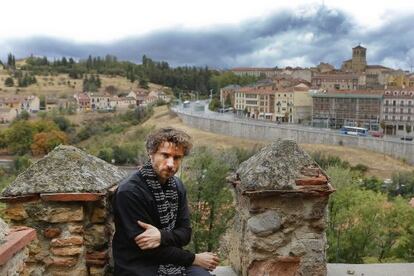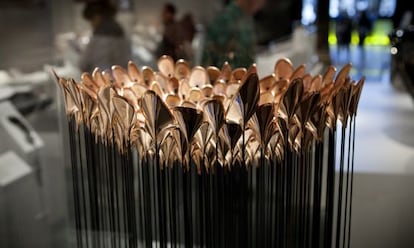A cauldron of creativity
Thomas Heatherwick, designer of the London Olympic torch, brings his bright ideas to the Hay Festival Segovia

"Like a pig looking for a truffle." That's how Thomas Heatherwick defines his job. No fan of labels - "words are dangerous," he says - the man who created the cauldron that lit up this summer's London 2012 with the Olympic flame, and dared to redesign the British capital's iconic double-decker buses, describes himself as neither a designer nor an architect. He'd like to be able to call himself an inventor, but "they have not yet created that qualification," he says.
The essence of the work that this Briton - who has been compared with Leonardo da Vinci - has spent the last 18 years creating at the head of his own studio is to be found in what surrounds him. "It is the world that positions me. I cannot understand those architects who deny reality in case it ruins their projects," he says in front of the aqueduct in Segovia, where he was due to talk at a conference organized by the IE University at the Hay Festival.
Dressed completely in black, with baggy pants and a scarf around his neck, he sports a monkish look that seeps into his mannerisms and words. He strolls along length of the Segovia monument, admiring the bravery of the Romans in constructing an irrigation system of such proportions in the middle of the city. "It sounds ingenuous and stupid, but what I like to do is help people," he says, now sheltered from the rain in the Mesón Cándido restaurant. "A public will drives me in my work. I'm more a fan of infrastructure than trophy buildings."
This philosophy, which he learned when he was a student at the Royal College of Art in London, and is now laid out in the book Making as well as at an exhibition at the Victoria and Albert Museum in the British capital, does not translate into mathematical or material terms. His speech is full of the ideas which, although utopian, to use his term, have become the hallmark of the British designer.
It sounds ingenuous and stupid, but what I like to do is help people"
"I don't think that I am an icon. In fact, I try to make my work respond to and respect the specific needs of a determined place. I have always been very afraid of the idea of a signature, of predictability, of someone being able to say to me that a building is mine because of the foundations."
To illustrate the peculiarity of his work he turns to the pavilion his studio created for the 2010 Expo in Shanghai. "The British government was terrified because we didn't use the image of the queen, the colors of the flag or David Beckham," he says. "They were demanding that we were in the top-five best buildings with a below-average budget. We managed it with a cathedral made out of metal hairs and seeds that demonstrated our respect for a public that is capable of responding when things are done from the heart and aren't imposing clichés."

A set designer, sculptor, tailor and furniture maker, as well as an architect, Heatherwick offers resistance against a trend that he calls "cold and boring." "Modern architecture is too imbued in theory and has forgotten that art is made on the basis of the human dimension. The technicians, the constant attempts to professionalize culture, bore me." After passing judgment, he provides the empirical evidence: the Teesside Power Station in the northeast of England. "We took down the fences surrounding a dangerous-looking place to turn it into a garden where people could get married, without forgetting its principle aim of supplying electricity to 200 homes."
Like a shepherd, he steers his team to respond to a question from a client with another question. "You always have to reformulate the question." That, he says, is the philosophy of his work. "When they commissioned us to create the cauldron for the Olympic Games, the first thing we did was ask people which of those that have been created they remembered."
The government was terrified because we didn't use the queen or David Beckham"
The result was not an object but an archer. The Spanish sportsman who lit the torch by firing a flaming arrow at the 1992 Barcelona Olympics became the idea behind the 204 moving pieces that for several seconds took away the breath of millions back in August. "It's all about the intrigue of unveiling a mystery. We weren't interested in round or square shapes, but in managing to create a moment to remember."
What followed is now a slice of Olympic history, if an ephemeral one. "We put the same effort into determining the end of the cauldron as we did to creating it," says Heatherwick.
"We didn't want our work to become a fountain in the middle of a stadium abandoned due to the passage of time and obscurity."
That's why each of the copper pieces worn out by the fire now rests in its country of origin. "It is going to sound ingenuous again, but I hope to have lifted up a great mirror in which people see that different things can be done."
Tu suscripción se está usando en otro dispositivo
¿Quieres añadir otro usuario a tu suscripción?
Si continúas leyendo en este dispositivo, no se podrá leer en el otro.
FlechaTu suscripción se está usando en otro dispositivo y solo puedes acceder a EL PAÍS desde un dispositivo a la vez.
Si quieres compartir tu cuenta, cambia tu suscripción a la modalidad Premium, así podrás añadir otro usuario. Cada uno accederá con su propia cuenta de email, lo que os permitirá personalizar vuestra experiencia en EL PAÍS.
¿Tienes una suscripción de empresa? Accede aquí para contratar más cuentas.
En el caso de no saber quién está usando tu cuenta, te recomendamos cambiar tu contraseña aquí.
Si decides continuar compartiendo tu cuenta, este mensaje se mostrará en tu dispositivo y en el de la otra persona que está usando tu cuenta de forma indefinida, afectando a tu experiencia de lectura. Puedes consultar aquí los términos y condiciones de la suscripción digital.









































